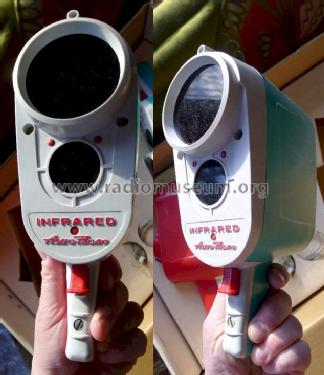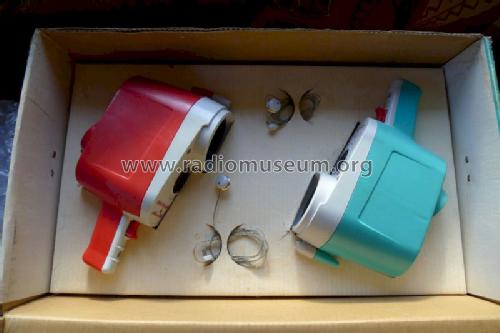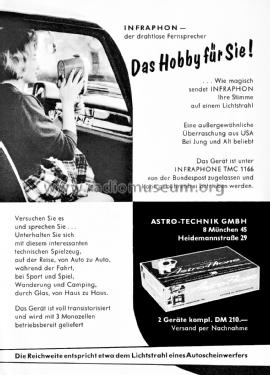Infrared Astro-Phone Walkie Talkie Infraphone TMC 1166
Infrared Industries Inc.; Waltham (MA)
- Pays
- Etats-Unis
- Fabricant / Marque
- Infrared Industries Inc.; Waltham (MA)
- Année
- 1960 ??
- Catégorie
- Amplificateur BF ou mélangeur BF
- Radiomuseum.org ID
- 196403
- No. de transistors
- Semi-conducteurs présents
- Semi-conducteurs
- Principe général
- Amplification audio
- Gammes d'ondes
- Bandes en notes
- Tension / type courant
- Piles sèches / R20: 3 x 1,5 Volt
- Matière
- Plastique moderne (pas de bakélite, ni de catalin)
- De Radiomuseum.org
- Modèle: Infrared Astro-Phone Walkie Talkie Infraphone TMC 1166 - Infrared Industries Inc.;
- Forme
- Portable, appareil de poche. Taille < 20cm
- Remarques
-
Infrared Astro-Phone Walkie Talkie;
From the frontiers of science, two way communications, earphones jack, set of two pieces.
Infrarot Lichtstrahltelefon.
Funktioniert, einfach ausgedrückt, mit einer Glühlampe in einem Parabolspiegel mit Transistorverstärker. Reichweite max. ca. 500 m.
Diese US Geräte kosteten 1963 in Deutschland 210 DM / 2 Stück.
- Auteur
- Modèle crée par d'un membre de A. Voir les propositions de modification pour les contributeurs supplémentaires.
- D'autres Modèles
-
Vous pourrez trouver sous ce lien 1 modèles d'appareils, 1 avec des images et 0 avec des schémas.
Tous les appareils de Infrared Industries Inc.; Waltham (MA)
Collections
Le modèle Infrared Astro-Phone Walkie Talkie fait partie des collections des membres suivants.
Contributions du forum pour ce modèle: Infrared Industries: Infrared Astro-Phone Walkie Talkie Infraphone TMC 1166
Discussions: 1 | Publications: 1
A reminiscence from a guest / visitor
"In 1960 my mother had a toy shop.
This device was totally in advance with its time and as such didn't sell so I had the opportunity to destroy it for educational purpose. It provided full duplex communication with a range of at least 100 meters. But being optical you had to be in line of sight and aiming was very critical. The transmitter was simply a pocket lamp bulb focused on an aluminium foil acting as the microphone. After reflection on that vibrating surface light came out from the bottom circular hole through a sliding infra-red filter..Partially removing the filter was to allow aiming at night.
The receiver used a mysterious 2 wires semiconductor at the focus of a reflector behind the big top circular hole. There was an infra-red filter here too. It was followed by a 3 transistors audio amplifier driving a crystal earpiece. There was probably some kind of AGC in the design.or the photo detector was not linear The small plastic tube on the top was a very simple visor.
Power was from 3 big 1.5V batteries..
Holding the two devices steady for long range communication was a real challenge as finding someone as crazy as you to play with..
So I mainly had fun with mirrors talking to myself or detecting AC powered light bulbs To my knowledge ,in spite of huge progress in optoelectronic, there was no other toys made using this design..
The fact that I remember in 2014 all those details from so long proves the educational value of that toy. I don't remember the name of the French distributor but I'm grateful to them too. Feel free to add this to your web page if you want."
By courtesy of Laurent Blin, Tille, France.
Now who is going to make one with an LED source? The modulation method solves issue of the low upper frequency limit modulating current on a filament. Apart from the dramatic saving in electronics! The receiver no doubt a photo diode or photo transistor feeding an audio amplifier.
Michael Watterson, 24.Mar.14





